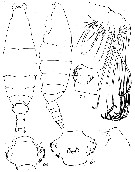|
|
 |
|
Calanoida ( Order ) |
|
|
|
Calanoidea ( Superfamily ) |
|
|
|
Megacalanidae ( Family ) |
|
|
|
Bathycalanus ( Genus ) |
|
|
| |
Bathycalanus eximius Markhaseva, 1983 (F) | |
| | | | | | | Ref.: | | | Markhaseva, 1983 (in Brodsky & al., 1983, p.197, Descr.F, figs.,F); Bradford-Grieve & al., 2017 (p.129, Descr F, Rem.) |  issued from : K.A. Brodsky, N. V. Vyshkvartzeva, M.S. Kos & E.L. Markhaseva in Opred. Faune SSSR, 1983, 135 (1). [p.196, Fig.87]. Female: habitus (dorsal and lateral, respectively); R, forehead and rostrum; Mx2; Gn, genital segment (dorsal, lateral and ventral: respectively Gn1, Gn2 and Gn3. Nota: Genital segment barrel-like. Complement from Bradford-Grieve & al. (2017, p.129): - Forehead, in dorsal view, with low prpjection bearing pair of small spine-like processes. - In lateral view, posterior corners of pediger 5 symmetrical, rounded, but slightly pointed in dorsal view. - Genital double-somite markedly swollen and symmetrical in dorsal view, wider than long, with lateral surfaces ornamented with large spinules. - A1 extending beyond caudal rami by 4-6 segments; anterior and posterior borders of ancestral segments XVI-XXI smooth.
|
 issued from : K.A. Brodsky, N. V. Vyshkvartzeva, M.S. Kos & E.L. Markhaseva in Opred. Faune SSSR, 1983, 135 (1). [p.197, Fig.87 (continuation)]. Female. Pmd = mandibular palp; Md = mandibular blade (gnathobase). Complement from Bradford-Grieve & al. (2017, p.129): - A2 exopod ancestral segment III with small seta and segment IV with short seta extending beyond segment VIII, no sign of setae on ancestral segments I and II. - Mx1 praecoxal arthrite with 14 setae including 3 on posterior surface and 1 longer and 1 smaller on anterior surface; coxal endite without setae; basal endites 1 and 2 with 2 and 4/5 setae, respectibvely; endopod segments with 2, 2, 5+1 small anterior surface seta; basal exite with 1 seta, epipodite with 7 long and 2 short, reduced setae. - Mxp syncoxa endite 4 longest seta extending beyond distal border of endopod segment 2; endopod segments 2-6 with 4 (including 3 small), 3 (including 2 small), 3 (including 2 small) + 1, 4 setae (2 large and 2 very small of which 1 on outer border), respectively. - P1 exopodal segment 3 with 1 outer border spine.
|
 Issued from : J.M. Bradford-Grieve, L. Blanco-Bercial & G.A. Boxshall in Zootaxa, 2017, 4229 (1). [p.91, Table 10]. Morphological characters after identification key of Bathycalanus females and males. Compare to other species of genus. Main characters identification after species key : 1 - Mx1 praecoxal endite without setae. 2 - Anterior margin of head with 2 very small spine-like processes. 3 - P1 exopod segments 2 and 3 separate; 4 - Pedigerous somites 4 and 5 without laterally extended lappets; Genital double not angular shaped. 5 - Genital double-somite very swollen in dorsal view, decorated with spinules. (male unknown).
| | | | | NZ: | 1 | | |
|
Distribution map of Bathycalanus eximius by geographical zones
|
| | |  Issued from : J.M. Bradford-Grieve, L. Blanco-Bercial & G.A. Boxshall in Zootaxa, 2017, 4229 (1). [p.84, Fig.46]. Issued from : J.M. Bradford-Grieve, L. Blanco-Bercial & G.A. Boxshall in Zootaxa, 2017, 4229 (1). [p.84, Fig.46].
Distribution of Bathycalanus species;
Bathycalanus richardi (filled squareç; Bathycalanus bradyi (filled triangle); Bathycalanus milleri (open triangle); Bathycalanus dentatus (open square); Bathycalanus tumidus (open circle); Bathycalanus adornatus (open diamond); Bathycalanus pustulosus (filled star); Bathycalanus unicornis ( (filled diamond); Bathycalanus bucklinae (filled circle); Bathycalanus eximius (cross). |
| | | | Loc: | | | N Pacifique (Kurile-Kamchatka Trench). | | | | N: | 1 | | | | Lg.: | | | (131) F: 11,9; {F: 11,90} | | | | Rem.: | Abyssal.
For Bradford-Grieve & al; (2017, p.129) this species is distinguished from all other Bathycalanus: 1- A very swollen genital double-somite bearing lateral spinules; 2- second basal endite of Mx1 with 4 setae. | | | Last update : 08/08/2018 | |
|
|
 Any use of this site for a publication will be mentioned with the following reference : Any use of this site for a publication will be mentioned with the following reference :
Razouls C., Desreumaux N., Kouwenberg J. and de Bovée F., 2005-2025. - Biodiversity of Marine Planktonic Copepods (morphology, geographical distribution and biological data). Sorbonne University, CNRS. Available at http://copepodes.obs-banyuls.fr/en [Accessed July 03, 2025] © copyright 2005-2025 Sorbonne University, CNRS
|
|
 |
 |






